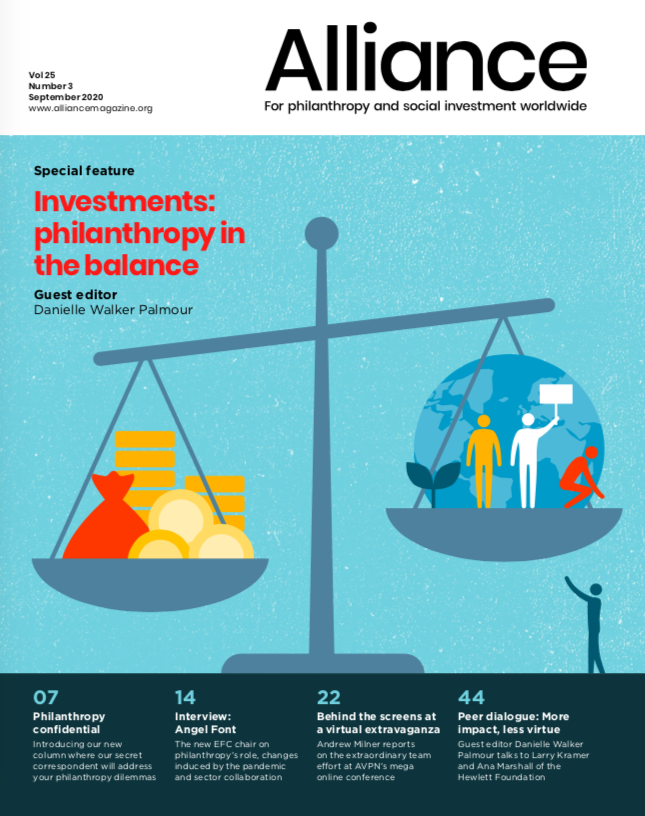Alliance goes behind the screens at the AVPN annual event and discovers an extraordinary team effort
‘We must have been crazy’ – that was the verdict of AVPN’s Naina Subberwal Batra on the decision to make this year’s conference an entirely online event. The challenges were formidable – converting what is in any case a logistically daunting event from a face-to-face to a virtual conference, learning a technology package from scratch and reaching out to an eventual audience of over 7,000 people in the space of a couple of months would make anyone think twice. So how did AVPN do it and what does their experience tell others?
When it started to become clear that the face-to-face event might fall victim to the Covid-19 pandemic, AVPN made contingency plans for both a live and a virtual event. Then, in mid-March, it was decided to hold the conference online. Making the decision actually took some of the pressure off, recalls Janice Zhang, AVPN’s events manger. ‘Before that, we were planning for two different scenarios, an in-person and a virtual conference,’ she says, ‘so when the government announced restrictions on the number of people who could get together, it was in some ways a relief. We could focus on one scenario.’
How did they do it?
The decision was taken to use two platforms, Adobe Connect and Zoom. Kevin Teo, AVPN COO and Alfred Poon, director of Digital Transformation, explained the reasons behind the choice. Zoom can only effectively accommodate a small number of participants. The next tier up is Adobe Connect’s seminar package. ‘Beyond that, you need live streaming which feels more like a podcast,’ says Teo, and the audience engagement is lower. ‘Mid tier was the sweet spot for us,’ he adds, with Adobe Connect allowing for a more flexible and dynamic event, which, in a small way helped to offset the physical remoteness of an online event. It allowed interaction with the speakers, audience polls and on-the-spot questions.
But why complicate matters by running two platforms? ‘We didn’t know how many people would join us,’ says Poon. ‘At first, we didn’t expect more than 1,500 people but anticipated numbers were increased quite a few times so we had to find a platform that could host that many people [and] we were hitting the upper limit of Adobe Connect.’ An added reason was that Zoom also allowed people with slightly lower bandwidth to join, and ‘especially our Chinese audience’ who cannot access Adobe Connect.
I think we got every single person of the AVPN team involved [around 60 people], including interns and volunteers… we became a community of very tech savvy individuals.
Starting from scratch
Having chosen the platforms, the team now had to find out how to use it – Adobe Connect was unknown to all of them, even AVPN’s established technical team. It was a considerable effort and required all hands on deck. ‘I think we got every single person of the AVPN team involved [around 60 people], including interns and volunteers,’ says Poon. In other words, the adoption of the new technology turned the conference preparations into an organisation-wide learning experience. ‘We got people who were more tech-savvy to become the technical support crew,’ says Poon, which freed up the established technical team for more specialised tasks. ‘We did have an external consultant come in to lead us initially, but the expert group within AVPN were soon able to lead. We became a community of very tech-savvy individuals,’ which, as he points out, may well have longer-term benefits for the organisation beyond this conference.
Pre-empting problems
Apart from learning the technology, they also prepared as fully as they could in advance. ‘We drew up a very long list of possible failure points,’ says Poon, ‘all the way to the worst-case scenario of the website crashing and no-one being able to access any sessions. So we prepared well in advance for all sorts of different contingencies, most of which didn’t need to be implemented.’ He adds: ‘I don’t think that if all 7,000 [registered participants] had gone to the website at the same time on Monday morning the website could have coped, but that didn’t happen.’ In fact, the highest number of people accessing the site at any one time was 1,017.
In addition to thoroughly preparing the staff, the speakers, all 156 of them, needed to be coached for the sessions to run smoothly. ‘We had multiple sessions with the speakers and moderators before the conference,’ explains Poon. ‘For each session, preparation was substantially more than for the physical conference…. we had to spend time getting each speaker comfortable with the package. That took up the team’s time.’
The largest cost, that of the entire AVPN team working with sponsors, curating content, prepping speakers/participants and delivering 40 sessions throughout the week, is relatively similar to that of a physical conference.
Of course, there were occasional hiccups – it’s worth remarking that there are during live events, too – occasionally, speakers were too muffled to be heard for part of their presentation or their connection temporarily dropped, but ‘we were actually expecting people to have more difficulty than they did,’ says Poon. ‘There were way fewer questions coming in from people about how to log in, how to download the app than we were expecting.’
Costs and participation
One of the potential benefits of running an online event is that it can be cheaper. The cost of the licence for Adobe Connect, increasing the bandwidth of the server and the buying in of external help from consultants would not have been incurred in the usual physical get-together. Against this, there is a saving on venue hire, catering, organisation of social events and all the ancillary costs of running a major event to consider. However, Zhang notes that, ‘the largest cost, that of the entire AVPN team working with sponsors, curating content, prepping speakers/participants and delivering 40 sessions throughout the week, is relatively similar to that of a physical conference.’
As Teo remarks, though, ‘the biggest advantage is the participation.’ Making the event virtual vastly increases the reach of the conference. The AVPN gathering is a huge one anyway – last year’s for example, was in excess of 1,200 attendees – but these numbers were dwarfed by the 7,400 eventual registrants at the online event. Attendance at sessions is limited only by bandwidth, not by the number of chairs you can get in a room. There were few concurrent sessions and the event ran over five days, so that people could attend more sessions. AVPN also introduced view-only tickets for the event, which meant that you could listen to sessions for much less than a ticket to the live event would cost. And while it’s clearly not worthwhile to spend money on a ticket and travel to Singapore to go to three or four sessions that grab your interest, it’s perfectly feasible to do this, to drop in and out, at an online event. All these things meant that the conference was much more accessible than the live event is and, as a result, attendance soared.
‘I wish I were actually in Singapore…’
This was a common lament from participants and, of course, the most obvious drawback to an exclusively online event is the absence of the opportunity for networking and for learning outside of the sessions, both traditionally great strengths of AVPN. While Adobe Connect helped to maintain a sense of the interactive, ‘there’s nothing like bumping into the person in a corridor or having a spontaneous introduction among friends’, acknowledges Teo.
While it’s clearly not worthwhile to spend money on a ticket and travel to Singapore to go to three or four sessions that grab your interest, it’s perfectly feasible to do this, to drop in and out, at an online event.
And no free beer!
This is not as facetious as it sounds. The social elements of a conference play an important role in forming relationships. Beer or not, free or not, getting together over a drink or sitting down to eat allows delegates to decompress from the intensity of listening and processing a lot of information and to explore their relationships in a more social setting. And if you are going to have a professional relationship with someone, it’s important to its quality that you get on.
Team-building
The intensity of concentrating on a screen without physical distractions can enhance people’s learning experience (though it’s also tiring). ‘Delegates seem to focus a lot more attention on the agenda and on the session itself,’ observes Zhang. ‘In a physical conference it’s easier to get distracted by connections and people they’ve met and our problem is usually how to get them into the rooms.’
If the online sessions sometimes provided a more conducive way of absorbing information than a live session for participants, the same was also true for AVPN staff. Content Marketing associate manager Amanda Kee usually spends her time at the physical conference ‘just running around but this year I had the chance to sit in and listen to the panels and one thing that really struck me was that there was more earnestness to learn especially against the backdrop of the pandemic. I think that came through a lot, much more so than in the physical conference when its a lot more about networking.’
The most obvious drawback to an exclusively online event is the absence of the opportunity for networking and for learning outside of the sessions, both traditionally great strengths of AVPN.
There’s another spin-off benefit, as we’ve already seen. ‘I think Naina said it well,’ says Poon, ‘when she said this was the best team-building experience you could ever have. It brought the team together and boosted their confidence.’
Future implications
Given the experience of the event, is AVPN likely to make future events online? Definitely, says Teo. ‘We’ve put a lot of blood, sweat and tears into mastering the platform,’ he says. ‘Even as we approach the next event in India, [the India Summit will be held in Gujarat, India from 8-11 December, 2020] we’re thinking it could make sense to hold a hybrid event, with a physical part to address the needs of the local audience, and at the same time draw in a wider audience in a cost-effective way.’ The same will apply to next year’s conference. It will be held in Bali, but will have virtual elements built into it.
The proof of any pudding is in the eating and feedback seems positive. ‘All of the staff got feedback from participants during the conference,’ says Irene Fischbach, a communications consultant with AVPN, ‘and the feedback was great.’ Teo adds, ‘we’ve got feedback from members and even from ex-colleagues who’ve said “it was fantastic that you pulled this together and that you’re still shining the spotlight on social investing in difficult times”. The appreciation has been tremendous.’
The event has shown that not only can a virtual conference on such a scale be held, it can be successful. It’s worth underlining two things in AVPN’s approach. First, preparation – picking the right platform for the kind of event you want to hold and anticipating as many contingencies in advance as possible and, second, involving the whole of the organisation in the endeavour.
Finally, there’s one more overwhelming advantage to a virtual event. People aren’t flying thousands of miles to go it. If all gatherings were virtual, of course, you would lose the personal dimension. No computer platform, no matter how sophisticated, can compensate for the absence of face-to-face interaction, but if you hold an annual conference, how about having a physical gathering every second year, and a virtual event in the alternate years? You would instantly cut the event’s carbon footprint in half. Something to think about.
Alliance was a media partner of AVPN’s 2020 conference.
Andrew Milner is associate editor of Alliance magazine.
Email: andrew@alliancemagazine.org











Comments (0)